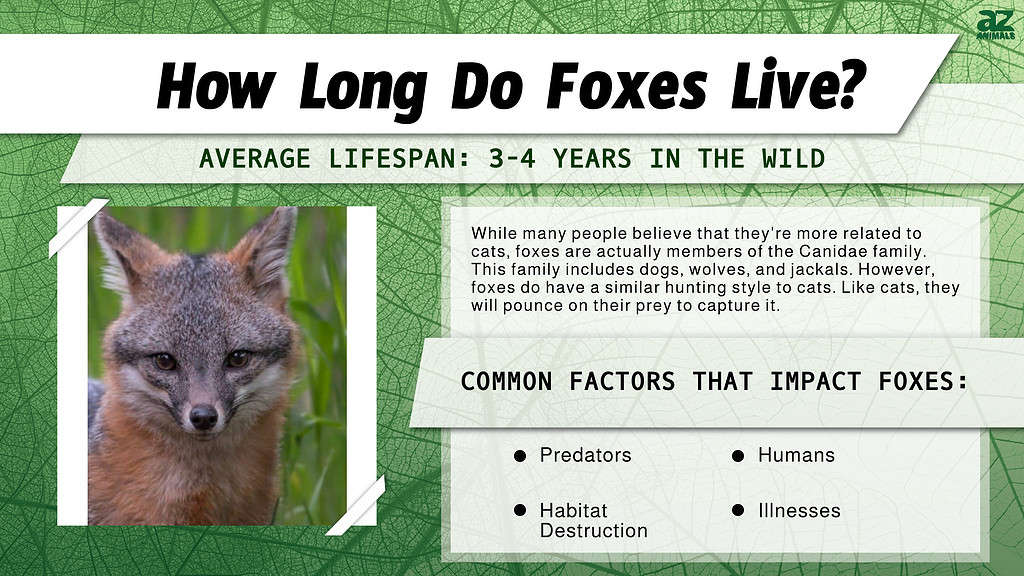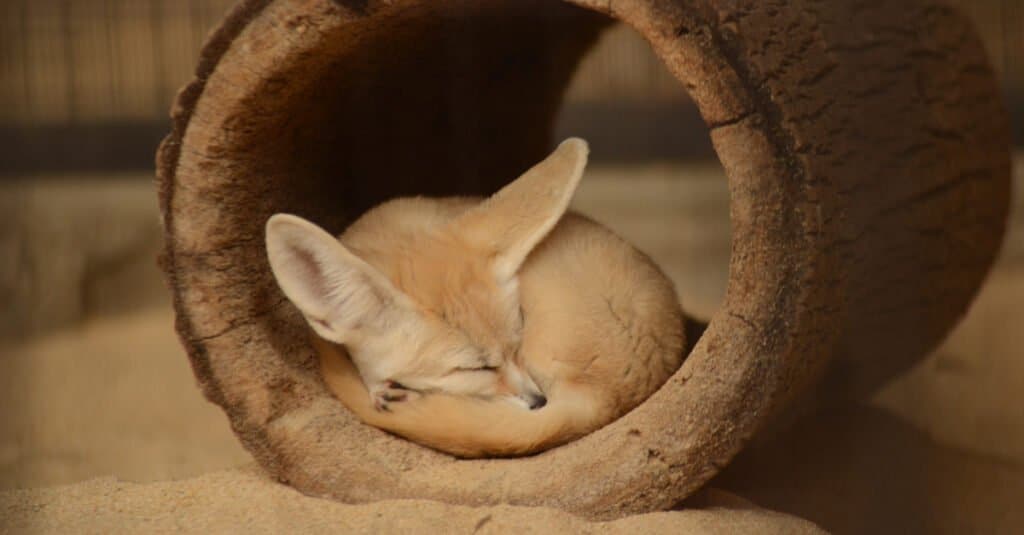
With their bushy tails and gorgeous coat colors, foxes are fascinating animals. Found all around the world, these intelligent animals are more cute than intimidating. You’re also far more likely to run into a fox than an animal such as a wolf. This is because foxes often thrive in cities and other rural areas.
Curious to find out more about this mysterious and elusive animal? We’ve got the rundown on foxes from their hunting style to the fox lifespan. So if you’ve been curious about how long foxes live and what their life cycle looks like, then read on!
The Rundown on Foxes

Foxes produce 40 different sounds.
©iStock.com/Rejean Bedard
Did you know that foxes are actually related to dogs? While many people believe that they’re more related to cats, foxes are actually members of the Canidae family. This family includes dogs, wolves, and jackals. However, foxes do have a similar hunting style to cats. Like cats, they will pounce on their prey to capture it.
While they might seem big from a distance, foxes are really only medium-sized. They can weigh anywhere between 2 to 24 pounds and have sharp features, slender bodies, and bushy tails. In fact, a fox’s tail makes up a third of its entire body’s length. As skilled hunters, foxes are classified as omnivores. They eat a wide variety of foods that include both live animals such as rabbits and birds, as well as berries and fruits.
Now that we better understand this sly animal, let’s dive into the fox’s lifespan and get a better idea of how long they can survive in the wild.
How Long Do Foxes Live?

In the wild, foxes can live up to 4 years, while in captivity, they can live for as long as 14 years.
©Ondrej Prosicky/Shutterstock.com
The average fox lifespan is 3-4 years in the wild. However, in captivity, foxes have been known to live much longer. Their average lifespan in captivity is 10 to 14 years.
Let’s take a look at the lifespans of a few memorable fox species:
- Arctic Foxes: According to Veterinary Parasitology, the lifespan of Arctic foxes is 4 years in the wild and up to 14 years in captivity.
- Red Foxes: Red foxes can live to be 2-6 years old in the wild and 10-14 years old in captivity.
- Fennec Foxes: Fennec foxes may live up to 10 years in the wild and 14 years in captivity.
As is evident, foxes in the wild have a much lower life expectancy.
The Average Fox Life Cycle
As they are related to other mammals in the Canidae family, the fox will go through a similar life cycle. Let’s find out more about how a fox goes about becoming an adult.
Pregnancy
Foxes become pregnant during the winter months, and their gestation duration ranges between 40 and 60 days, depending on the species. When a female fox becomes pregnant, she prepares her birthing burrow, where she will give birth to her fox cubs.
Canids are unique among mammals in that they have a single ovulatory phase. However, according to Canine Life History, fennec foxes, crab-eating foxes, and bat-eared foxes have been observed to sometimes have a second cycle per year in the wild and/or captivity.
Newborn Pups
Once the mother’s gestation period is over, she will give birth to her kits. Fox babies have a few different names which include kits, pups, and even cubs. A typical kit litter size will range from 3 to 5 kits per litter. When the kits are first born they are blind, deaf, and dark grey in color.
Fox Cubs

The Fennec fox’s sandy coloration allows heat to be reflected.
©natapornL/Shutterstock.com
The cubs begin to venture outside of their den after around 4 weeks. Even so, they won’t venture far, preferring to stay close to the protection of the den and their mother. Their instincts will begin to kick in during this time. They will start to forage and hunt, preying on insects and worms.
Juveniles
After about 12 weeks, the foxes begin foraging entirely for themselves. This is also the age at which they are the most vulnerable to death. Foxes that survive past 12 weeks of age will more likely make it to a year. At this point in their life, they still won’t venture too far away from their den.
Adulthood
At a year old, a fox is finally considered an adult. It is at this point in their lives that they may leave their mother’s den and begin their own lives. Once winter approaches, the fox is ready to procreate. Thus, the cycle of the fox continues again.
How Does Their Lifespan Compare to Other Canids?

Compared to other canids, foxes have a short lifespan.
©Davebluedevil / CC BY 2.0, via Wikimedia Commons – License
Canid species have a lifetime ranging from 3 to 15 years in the wild, although most species may live much longer in captivity. Wild wolves will live anywhere between 5-15 years in the wild. Foxes and dogs are members of the same animal family, Canidae, although their ancestors diverged after that. Domesticated dogs, on the other hand, average much longer lives than a fox. Their lifespan is typically 10-13 years.
Common Factors That Affect A Fox’s Lifespan
Foxes are the smallest members of the Canidae family, meaning that they are not at the top of the food chain. From natural predators to hunters, there are lots of factors that influence the fox’s life. So what exactly shortens the fox’s lifespan? Let’s explore the top factors that impact their lives:
- Predators: Since foxes are pretty small, they are often preyed upon by much larger animals. Foxes must watch out for mountain lions, wolves, coyotes, and even owls! Humans are also a major predator as foxes are often hunted for their fur, and their natural habitats become destroyed.
- Illness: Many foxes are susceptible to parasitic infections, one in particular called mange. The mites from mange can cause hair loss and itching. Without fur, they have nothing to keep them warm during the cold winter months.
- Habitat destruction: With humans taking up so much natural land, foxes have begun to dwell in many urban areas. This leaves them susceptible to unnecessary deaths such as being hit by a car.
The photo featured at the top of this post is © iStock.com/Hawk Buckman
Thank you for reading! Have some feedback for us? Contact the AZ Animals editorial team.






